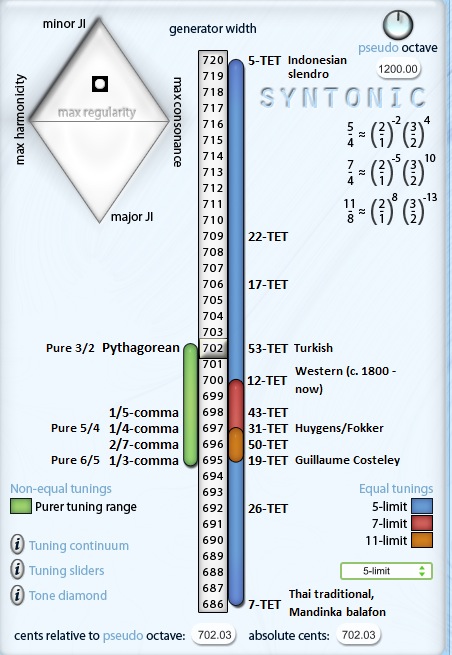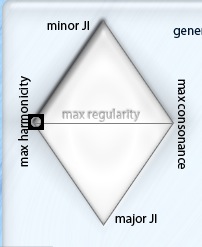

About Dynamic TonalityIn the TransFormSynth, both the tuning of the notes and the timbre of the notes can be changed in real time using simple sliders and buttons. In the same way that MIDI pitch bend jiggles the pitch of a note up and down while playing, the TransFormSynth can wiggle the pitches of all the currently playing notes -- but they do not necessarily all move in the same direction by the same amount. Rather, they move in a patterned way that is consistent with the current tuning and sound. They move in the right direction by the right amount. Even more, the TransFormSynth can wiggle the timbre (more accurately, the locations of the overtones) in musical and patterned ways. The very structure of sound itself is controllable with a few simple gestures.
A tuning slider, as shown below, can change the size of the fifth (or of some other relevant interval, depending on the continuum chosen). As the slider moves, the tuning interpolates among a wide variety of familiar and unfamiliar tunings. For example, the syntonic continuum contains 5-tet (five equally spaced tones per octave), 22-tet, the familiar 12-tet, 19-tet, and 7-tet. Moreover, it contains a number of historically useful tunings such as meantone and Pythagorean. Instead of painstakingly retuning the keyboard (or sound module) to perform in each tuning separately, the slider interpolates between all these tunings so that the changes are continuous, smooth, and musically interesting. It is a bit like pitch bend, but with all notes of the tuning participating. Again, the overtone structure of the sound is changed in synchrony so that all the overtones "line up" as much as possible. 
Two-dimensional controllers such as this tone diamond adjust the timbre with its horizontal motion (to the left makes a sound harmonic with all overtones aligned to a single harmonic series, to the right tempers the timbre so as to maximize sensory consonance). The vertical direction interpolates between the specified tuning and nearby just intonations (at the bottom and top are major and minor JIs, in the middle is the tuning specified by the generators). 
|
©2008 William Sethares; site design by Anthony Prechtl |